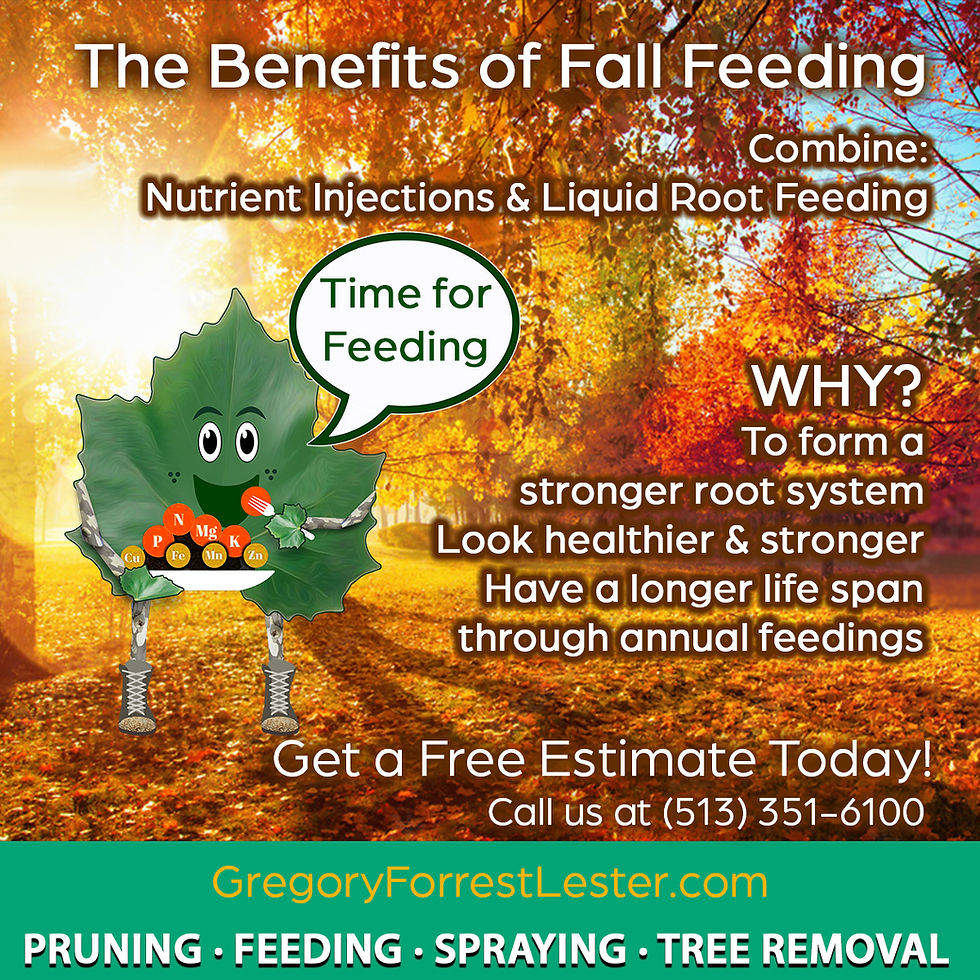Comprehensive Tree Disease and Pest Treatment
- Kevin Lester

- Feb 26, 2024
- 4 min read
Updated: May 17, 2024
Maintaining the health and vitality of trees is essential for preserving the beauty and ecological balance of urban landscapes. Trees, like all living organisms, are susceptible to various diseases and stressors that can compromise their well-being. Effective tree disease treatment requires a deep understanding of arboriculture, precise diagnostic skills, and the application of advanced treatment methods.
In Cincinnati, Gregory Forrest Lester, Inc stands out as the premier authority in tree health management. With a legacy of expertise spanning decades, we have earned a reputation for excellence in diagnosing and treating tree diseases. Our holistic approach combines cutting-edge techniques, making us the trusted choice for tree care needs in the region.
Integrated Tree Care Solutions:
At Gregory Forrest Lester, Inc, our approach to tree health encompasses a comprehensive range of solutions tailored to each tree's unique requirements. Among our arsenal of tools, micro-injections and foliar sprays play pivotal roles in combating diseases and nourishing trees back to health.
Professional Guidance and Monitoring for Tree Disease and Pest Management:
Arborist Expertise: Certified arborists assess the specific pest and disease pressures facing trees in Cincinnati, tailoring treatment plans to include effective tree disease treatments for individual tree species and health conditions.
Regular Monitoring: Ongoing monitoring allows arborists to track the effectiveness of tree disease treatments and make adjustments as needed to ensure optimal tree health and vitality.

Targeted Treatment Approaches:
Micro-Injections:
Precision Targeting: Micro-injections deliver tree disease treatments directly into the tree's vascular system, ensuring systemic distribution and efficacy against internal pests.
Long-lasting Protection: Once injected, the treatment circulates throughout the tree, providing extended protection against pests.

Foliar Sprays:

Rapid Response: Foliar sprays act quickly as tree disease treatments to address external pests and diseases, targeting pathogens or insects present on the tree's foliage.
Localized Application: Foliar sprays can be applied selectively to affected trees or areas, minimizing environmental impact while maximizing treatment effectiveness.
Common Tree Pests and Diseases in Cincinnati:
Emerald Ash Borer (Agrilus planipennis):

Pest Description: This invasive beetle attacks ash trees, causing significant damage by tunneling into the tree's vascular system and disrupting nutrient transport.
Treatment Approach: Micro-injections with systemic insecticides are effective tree disease treatments against emerald ash borer larvae, providing long-lasting protection.
(Calonectria pseudonaviculata):

Disease Description: Boxwood blight is a fungal disease that affects boxwood shrubs, causing leaf spots, defoliation, and dieback.
Treatment Approach: Foliar sprays with fungicidescan serve as tree disease treatments, helping prevent the spread of boxwood blight and protect the foliage from infection.
Anthracnose (Various fungal species):

Disease Description: Anthracnose is a fungal disease that affects many trees, including maple, oak, and sycamore. It causes leaf spots, defoliation, and can weaken the tree over time.
Treatment Approach: Systemic treatments for anthracnose involve administering fungicides that are absorbed by the plant, targeting the fungus internally to combat the disease effectively. Foliar sprays with fungicides can be used as tree disease treatments on affected trees to prevent the spread of anthracnose and protect new foliage.
Japanese Beetles
(Popillia japonica):

Pest Description: Japanese beetles feed on a wide variety of trees and plants, skeletonizing leaves and causing extensive damage.
Treatment Approach: Foliar sprays with insecticidescan be applied as tree disease treatments to deter Japanese beetle feeding and reduce their population on susceptible trees.
Scale Insects
(Various species):

Pest Description: Scale insects are sap-feeding pests that can infest a wide range of trees and shrubs, including magnolias, euonymus, and citrus trees. They weaken the tree by draining sap and can cause yellowing leaves, stunted growth, and branch dieback.
Treatment Approach: Micro-injections can target scale insects within the tree, providing long-lasting control and protecting the tree from infestations.
Verticillium Wilt
(Verticillium spp.):

Disease Description: Verticillium wilt is a fungal disease that affects a variety of trees, including maples, elms, and ash trees. It causes wilting, leaf yellowing, and branch dieback as the fungus infects the tree's vascular system.
Treatment Approach: Micro-injections with fungicides can suppress the spread of Verticillium wilt within the tree, providing systemic protection against the fungal pathogen.
Hemlock Woolly Adelgid
(Adelges tsugae):

Pest Description: Hemlock woolly adelgids are tiny aphid-like insects that infest hemlock trees, feeding on sap and causing needle loss, branch dieback, and eventual tree death.
Treatment Approach: Micro-injections with systemic insecticides can target hemlock woolly adelgids within the tree, providing systemic control and protecting the hemlock from infestation.
Powdery Mildew:

Disease Description: Powdery mildew is a fungal disease caused by various species of fungi. It appears as a white, powdery substance on the leaves, stems, and sometimes flowers of affected plants. It thrives in warm, dry conditions and can spread rapidly, leading to leaf distortion, premature leaf drop, and reduced plant vigor.
Treatment Approach: Fungicidal sprays containing ingredients like sulfur or potassium bicarbonate can effectively control powdery mildew. Additionally, cultural practices such as improving air circulation around plants and avoiding overhead watering can help reduce the spread of the disease.
Nipple Gall:

Disease Description: Nipple gall, also known as crown gall, is a bacterial disease caused by Agrobacterium tumefaciens. It forms tumor-like growths or galls on the stems, branches, and sometimes roots of trees. These galls can vary in size and appearance but often have a rough, irregular surface. Nipple gall can weaken the affected tree, leading to stunted growth, reduced vigor, and in severe cases, death.
Treatment Approach: Prevention is key to managing nipple gall. Planting disease-resistant tree varieties and ensuring proper pruning practices can help minimize the risk of infection. Infected plant parts should be promptly removed and destroyed to prevent the spread of the bacteria. Soil drenches with bactericides containing Agrobacterium radiobacter may also aid in controlling the disease.
By employing targeted treatment approaches such as micro-injections and foliar sprays, and with the guidance of experienced arborists, trees in Cincinnati can be effectively protected against the threats posed by common pests and diseases, with specialized focus on tree disease treatment protocols for each identified issue.



